

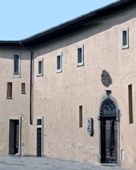
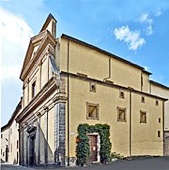
Sant’ Onofrio (nuns’ church) Chiesa del Buon Gesù
Cardinal Girolamo Simoncello acquired this site in 1559 to provide a home for spinsters who lacked resources and protection. The first Franciscan nuns moved her a few months later. Adjacent properties were acquired in 1560-2. Pope Paul V gave his permission for the construction of a new church on the site, and Bishop Cardinal Giacomo Sannesio laid its foundation stone in 1618.
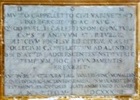
Cardinal Aldobrandini (Ippolito Aldobrandini, nephew and namesake of Pope Clement VIII?] gave the nearby church of Sant' Onofrio (to the left of the main church, illustrated above) to the nuns in 1633 to serve as their enclosed chapel (a function that it still performs).
The nuns here had a close association with those at the nearby nunnery of Santa Chiara. Both communities were suppressed in the Napoleonic period. The nuns managed to return to the Monastero del Buon Gesù, but Santa Chiara never re-opened.
The nuns regularly celebrate lovely choral masses that are open to the public (see the times posted on the side door).
Interior
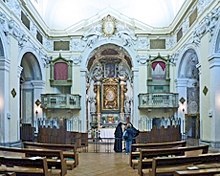
The interior stucco work was financed in ca. 1660 by Sister Ippolita Simoncelli.
Madonna in Morto Vivo (15th century)
Scenes from the lives of Christ and the Virgin (1647)
The will (1647) of Giovanni Battista Cecchetti included a bequest to his sister Giulia, who was a nun here, that was to be used to commission Salvi Castellucci to decorate the “frontespizio” (almost certainly the apse) of church and the vaults. In fact, this work is attributed on stylistic grounds to Giovanni Maria Colombi.
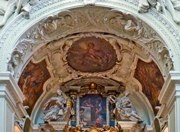
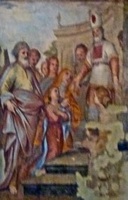
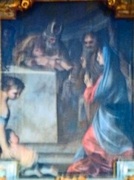
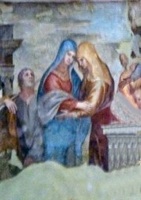
Presentation of the Virgin Presentation of Christ Visitation
The works comprise:
-
✴a panel of the Presentation of Christ, above the high altar; and
-
✴the following frescoes in the apse:
-
•three in the vaults:
-
-the Adoration of the Magi (to the left);
-
-the baby Jesus in glory; and
-
-the Nativity (to the right); and
-
•two on the walls:
-
-Presentation of the Virgin (to the left); and
-
-the Visitation.
Birth of the Virgin (17th century)
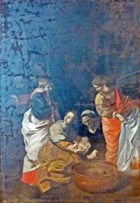
Art from the Church
Profession of St Clare (1637)
This altarpiece in the nuns’ private chapel came from Santa Chiara. It was taken to Paris in the Napoleonic era, when the nunneries of Orvieto were suppressed, but subsequently returned to city. Since Santa Chiara never re-opened, it was given to the nuns of the Chiesa del Buon Gesù.
The altarpiece depicts St Clare receiving the habit of a nun from St Francis at the Portiuncula. An inscription was recently discovered on it identified the artist as Giovanni Maria Colombi and gave the date as 1637.
Angel (early 16th century)
This painted terracotta figure in the Museo dell’ opera del Duomo came from the cloister of the nunnery. It might originally have been housed in the lunette above an altarpiece or a porta. It formed part of a larger work that might have depicted the Annunciation or perhaps a figure of Christ or the Virgin between two angels.

